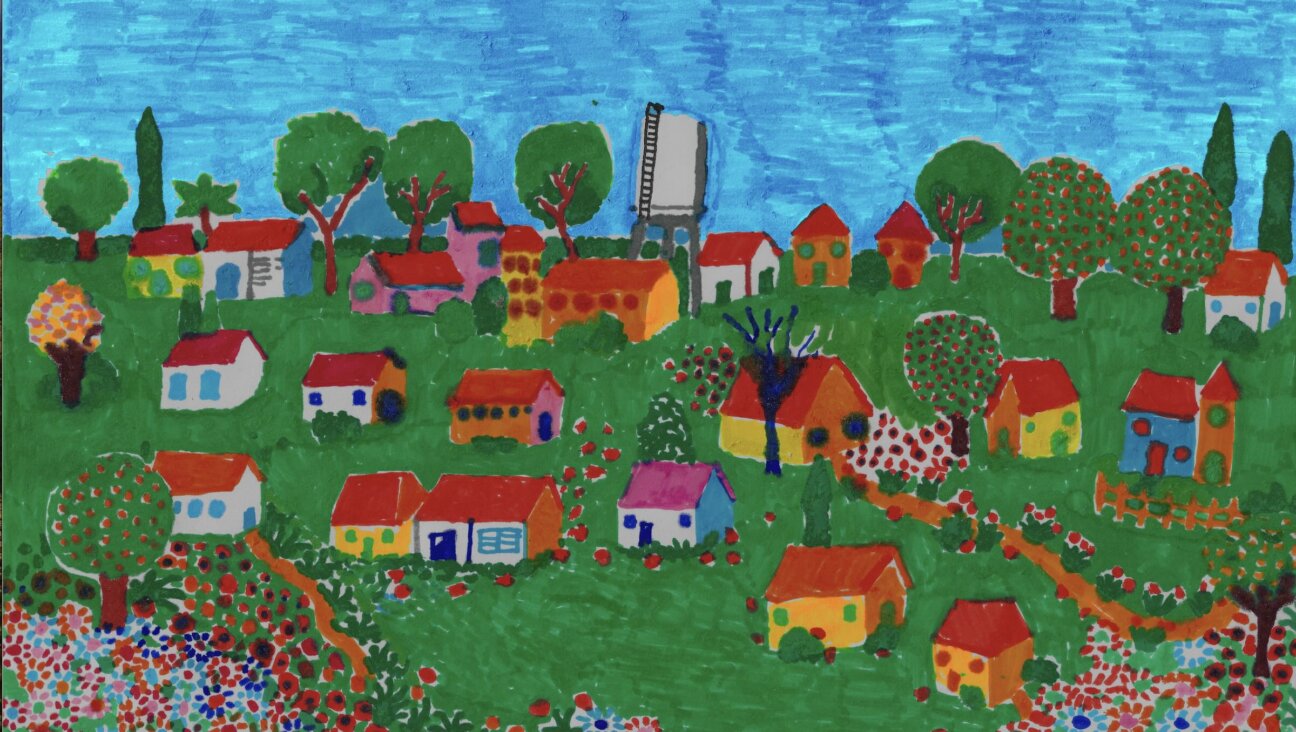How Filmmakers Are Using Videotherapy To Help the Bereaved in Israel

Image by Anya Ulinich
In the Israeli short “Where To?” a middle-aged man, Ofir Shaer, and his pals are looking forward to a major ball game. But it’s not just any ball game — this one is a memorial to his late son. It soon becomes clear that Shaer is so focused on his dead child that he has forgotten his living son, a cartoonist who is receiving a major award on the same night. Father and son have an embarrassing blowout in front of the others. In the end, Shaer, dressed in formal wear, is getting ready to attend the awards ceremony.
The eight-minute film features seven fathers (these are not professional actors), all of whom have lost children to war, terrorism or natural disasters within the past two years. And it’s the end product of a unique videotherapy program at the Ma’aleh School of Television, Film & the Arts, in Jerusalem.
For more than a decade, the school has produced a host of films centering on such groups as bereaved families, victims of terrorism and high-risk teens. These films, written by and starring the participants themselves, have been created under the joint direction of a social worker or psychologist and a filmmaker who have gone through a formal eight-month videotherapy-training program at the school. The theory is that a profound connection exists between filmmaking and therapy, and that there is uncanny healing potential in joining the two into a single entity: videotherapy.
“It’s a new model and no studies have been done on it, but on the basis of what we’ve seen and been told by the participants, it’s working. They’re feeling better and functioning on a higher level. The problems are not gone, but there’s a big improvement,” said Miri Boker, an occupational therapist who founded this form of videotherapy and heads the program at Ma’aleh. “Research is now needed to confirm what we’ve observed and know in our hearts to be true.”
Shaer, whose teenage son, Gilad Shaer, was kidnapped and murdered (along with two other boys) by Palestinian terrorists in 2014, described the making of the film as a complex experience often defined by wanting to run away followed by an intense need to come back. It was a new universe for him — from voicing feelings without feeling stigmatized to learning the new language of filmmaking to his deep connection with the other men. “When I started I knew nothing about any of it,” he recalled. “It was all a big surprise, but I soon discovered that something very important was happening.”
Though videotherapy incorporates support group elements, the goal is to make a film, admittedly one that has resonance for each member. Through a series of exercises — and these vary depending on who’s in the group — a shared trauma or conflict is uncovered. For the bereaved men it was troubled family relations, dealing specifically with a surviving child who is often ignored in the wake of his/her sibling’s death. That topic became the springboard for the script.
Storytelling was (and is) the key. Creating a narrative, shaping and structuring the senseless horror, gave the men a degree of control over it, all the more so when they saw it work as a short feature.
“At every step — from the script writing to the editing to the shooting — each participant has a chance to look at what happened again, deconstruct and reconstruct his story,” Boker explained. “And at the end, when he sees the finished product, it’s yet another step in the healing process.”
The participants join the group in any number of ways, most notably through Ma’aleh’s vast social media network. Many wives of the men who participated had worked on a film about their experiences (as bereaved mothers) a year earlier. The women were able to introduce their husbands to the idea of videotherapy.
Still, there was real concern that working with the men would be challenging, since men are often thought to be uncomfortable expressing feelings. As it turned out, that was not the case. Nonetheless, the team approached the men — as a first step to accessing their emotions — with activities and projects directly related to filmmaking as opposed to a lot of talk.

Drawing Out Emotions: The Ma’aleh School of TV, Film and the Arts in Jerusalem takes a novel approach to aiding the bereaved. Hillel Klein, pictured here, has studied at the school. Image by Ma'aleh
During the course of 24 two-hour sessions — stretched across eight months — the first 12 meetings centered on the technicalities of the filmmaking process.
Ultimately, each man was asked to create a short film (with no words, only music) depicting the ideal character. One film portrayed a beleaguered man whose phone doesn’t stop ringing. Every time he wants to do something else — get a cup of coffee or go to the bathroom — the phone rings. Finally he shuts off the phone. Life is lovely without intrusion.
Another short featured a character who desperately wants to play ball again, but for some reason feels emotionally paralyzed. In the end, he’s on the basketball court, approaching a youngster who is playing by himself, and the two of them shoot hoops together.
The early film exercises were seemingly unrelated to the men’s traumas, but the little movies were oddly revealing (also funny and sad), and for complex, perhaps not readily, discernible reasons, they paved the way for further discussion that ultimately led to a collectively written script reflecting aspects of their common experience as bereaved fathers. The story and characters were autobiographical composites. Who played what role was largely voluntary. Many participants worked behind the camera as well.
“One of the most fascinating discussions I witnessed was on the topic of location,” recalled the film’s director, Keren Hakak. “When I asked, ‘Where do you want the story to take place — in the deceased child’s bedroom or the living room?’ the discussion that followed could have been coming from professionals. They discussed it from all angles, and the conversation went on for a long time. It was astonishing. They settled on the living room.”
Choosing the living room also pointed to how far they had already moved, psychologically speaking. In most cases, the door to their late child’s room was open, no longer a closed memorial shrine.
“The living room, the center of the house, represents the whole family,” Hakak said. “It has more air and space. It’s where life goes on.”
“For me, the most meaningful moment was towards the end, when we were finishing the film,” Shaer said. “It was a very long day, 8 a.m. to midnight. At 10 p.m., when we usually stopped working, we sat back for a moment, asking each other if we should stop for the night. We decided we’d stay as long as it took to finish. We really wanted to be together and do the job. We didn’t want to leave.”
Still, it’s not an easy process for anyone, including Hakak and Asher Lemann, the social worker on board, who faced many challenges.
Hakak admitted frankly that at 33 she felt presumptuous attempting to tell grown men — especially those who had gone through the horror of losing a child — anything about life.
“I had to accept the fact that they know more about life than I do, but as a professional I had the tools to tell a story through film,” she recalled. “I also know through my own personal experience how the filmmaking process teaches you to make choices. That’s an important word, ‘choice.’ In every art form you’re making choices. And that applies to life, too.”
Lemann also cited the challenges of collaborating with adults. In his day job, he is a parole officer at the Ministry of Social Affairs, dealing with troubled teenagers.
“You have to understand that in Israel, people who lose children, especially in the military or as a result of terrorist attacks, are viewed as very special and treated with great delicacy,” Lemann said. “In the beginning it was difficult for me to ask the hard questions and do it with sensitivity. I soon realized a lot of what we discussed — or did not discuss — had to do with the fact that only two years had passed since the child’s death. We could talk about coping with other family members, but not the actual loss of the son or daughter.”
All agree that these films have a definable aesthetic and that artistic choices are made throughout the process but creating great art is not the goal, nor is speaking to large or even small audiences. Some participants may want their films viewed by friends and family and on some occasions even the public at large, but more often than not they’d prefer no audiences, short of the players themselves. For most it is an intensely private experience.
By contrast, Shaer said he’d like the public to see the film, suggesting it might have special resonance for those who’ve experienced traumas. And even for those who haven’t, it’s useful for them to know “you can be in pain, but you can also choose to live a good and meaningful life. We all wear a lot of hats. There isn’t only one hat that defines you. I’m a father who lost his son. It’s a part of me, but it’s not all of me. And it’s complicated. Two steps forward, one step back. Last week my oldest daughter got married. There was great happiness and great pain. But we handled it.”
Simi Horwitz, who has won numerous New York Press Club and Simon Rockower Awards, is the author most recently of ‘Jewish Art Today: News, Views and Cultural Trends,’ a collection of essays originally published in the Forward (Hadassa Word Press).
A message from our Publisher & CEO Rachel Fishman Feddersen

I hope you appreciated this article. Before you go, I’d like to ask you to please support the Forward’s award-winning, nonprofit journalism during this critical time.
We’ve set a goal to raise $260,000 by December 31. That’s an ambitious goal, but one that will give us the resources we need to invest in the high quality news, opinion, analysis and cultural coverage that isn’t available anywhere else.
If you feel inspired to make an impact, now is the time to give something back. Join us as a member at your most generous level.
— Rachel Fishman Feddersen, Publisher and CEO





















